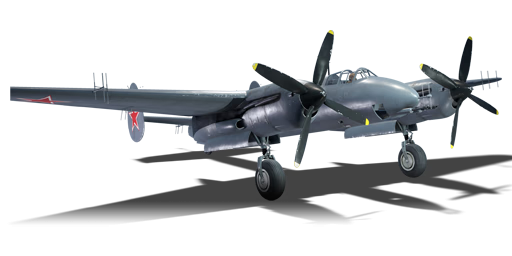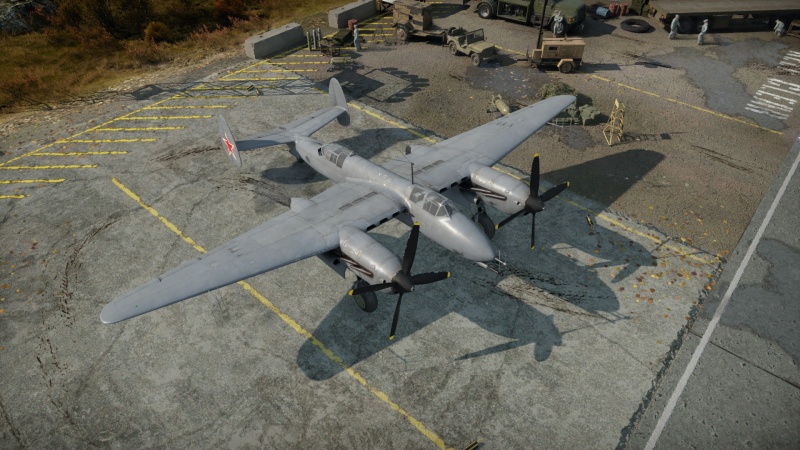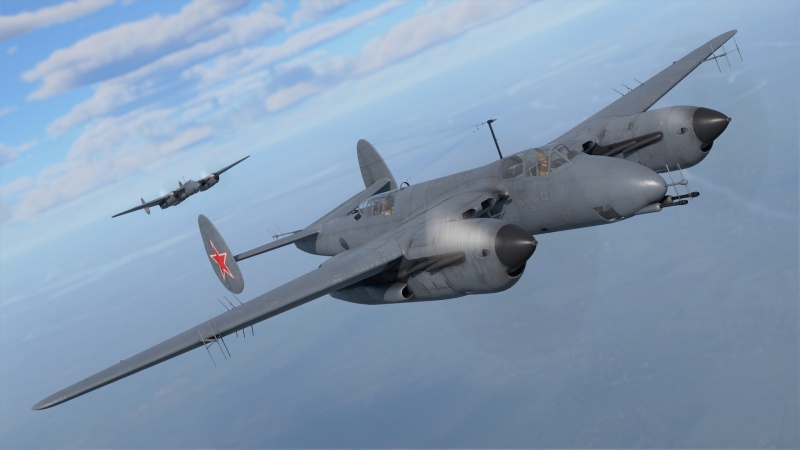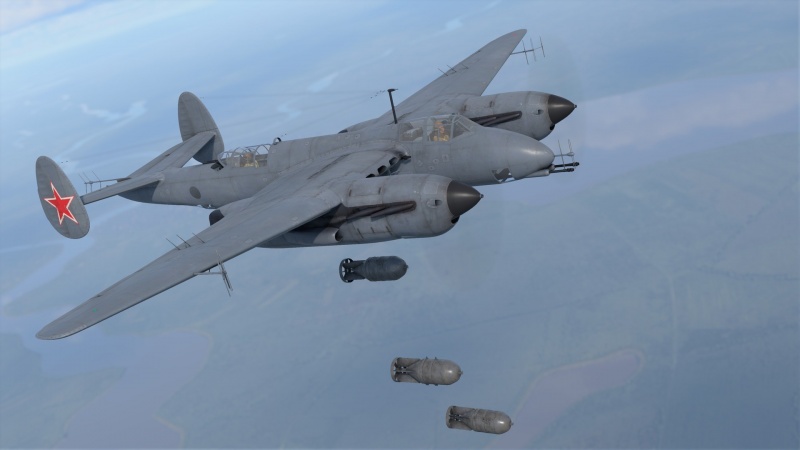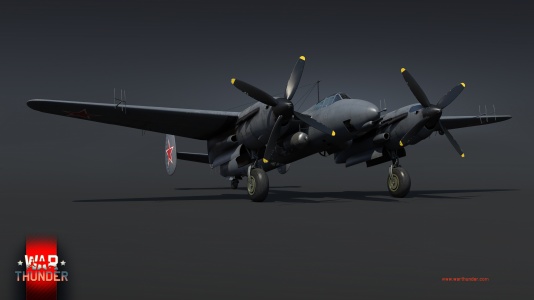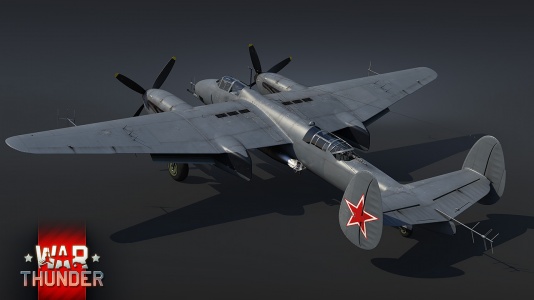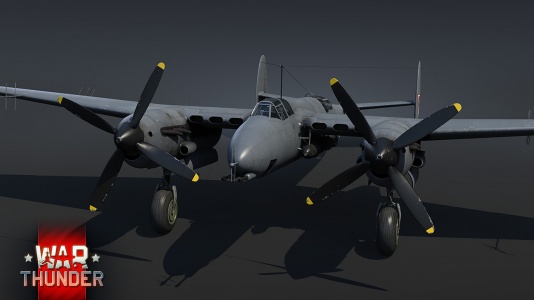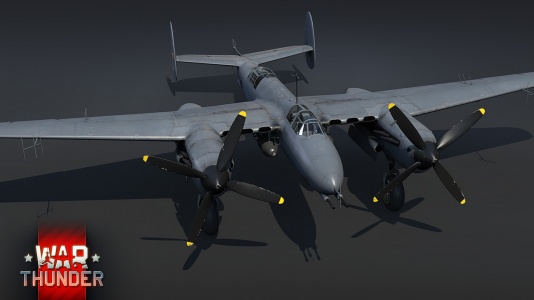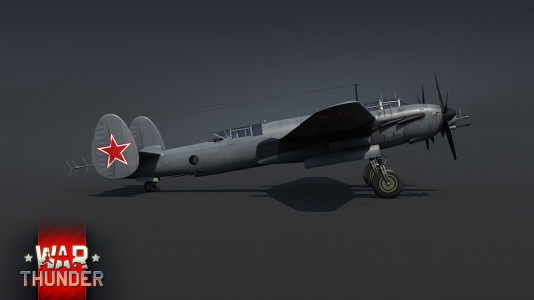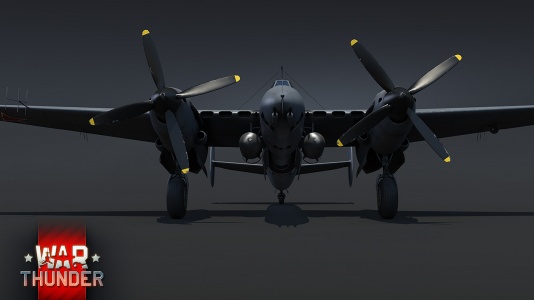Difference between revisions of "Tu-1"
Inceptor57 (talk | contribs) |
m (Incorrectly called the 1000kg bomb as 1000lb bombs) |
||
| (4 intermediate revisions by 3 users not shown) | |||
| Line 1: | Line 1: | ||
{{Specs-Card | {{Specs-Card | ||
|code=tu-1 | |code=tu-1 | ||
| − | |images={{Specs-Card-Image|GarageImage_{{PAGENAME}}.jpg|StoreImage_{{PAGENAME}}_001.jpg|StoreImage_{{PAGENAME}}_003.jpg | + | |images={{Specs-Card-Image|GarageImage_{{PAGENAME}}.jpg|StoreImage_{{PAGENAME}}_001.jpg|StoreImage_{{PAGENAME}}_003.jpg}} |
| − | |||
}} | }} | ||
== Description == | == Description == | ||
<!-- ''In the description, the first part should be about the history of and the creation and combat usage of the aircraft, as well as its key features. In the second part, tell the reader about the aircraft in the game. Insert a screenshot of the vehicle, so that if the novice player does not remember the vehicle by name, he will immediately understand what kind of vehicle the article is talking about.'' --> | <!-- ''In the description, the first part should be about the history of and the creation and combat usage of the aircraft, as well as its key features. In the second part, tell the reader about the aircraft in the game. Insert a screenshot of the vehicle, so that if the novice player does not remember the vehicle by name, he will immediately understand what kind of vehicle the article is talking about.'' --> | ||
| − | The | + | While working on the [[Tu-2]] bomber, Tupolev was inspired to design a multipurpose aircraft capable of intercepting, bomber escort, and ground attack. First, a Tu-2 was modified to fit this task, and the military was interested enough to authorize the development of the new aircraft as a heavy fighter. Even when the war broke, the development continued, although this was slowed due to the Tu-2 becoming a priority. The aircraft was specially designed for interception and ground attack, featuring a radar in the nose, two 45 mm NS-45 guns installed in the front of the bomb bay, and two 23 mm NS-23 guns in the wings. With a crew of three, one pilot and two defensive gunners, the entire back of the aircraft was covered, both above and below the fuselage. While the tests in 1947 for the aircraft were successful, jet-powered aircraft started to be more and more common, and thus the project was scrapped. |
| + | |||
| + | It was introduced in [[Update "Direct Hit"]]. The '''{{Specs|name}}''' features a good number of advantages for the ground attack role. It has a very powerful armament and a good top speed; the four cannons are more than enough to deal with both ground and air targets, although the 45 mm cannons don't have the accuracy or rate of fire to be effective in air combat. To deal with ground targets, the set of three 1,000 kg bombs are excellent to deal with large quantities of enemies. One of these bombs is usually enough to destroy all targets in a capture point. For naval battles, the Tu-1 is also able to two 450 mm torpedoes that, while not the strongest, are capable enough to destroy light cruisers and destroyers. It should be noted that as a heavy fighter the acceleration is mediocre, and you should avoid dogfights as much as possible. | ||
== General info == | == General info == | ||
| Line 13: | Line 14: | ||
{{Specs-Avia-Flight}} | {{Specs-Avia-Flight}} | ||
<!-- ''Describe how the aircraft behaves in the air. Speed, manoeuvrability, acceleration and allowable loads - these are the most important characteristics of the vehicle.'' --> | <!-- ''Describe how the aircraft behaves in the air. Speed, manoeuvrability, acceleration and allowable loads - these are the most important characteristics of the vehicle.'' --> | ||
| − | The Tupolev Tu-1 has a high top speed. However, its acceleration is noticeably slow as it is a heavy aircraft and it is degraded even further by the drag of bombs carried externally | + | The Tupolev Tu-1 has a high top speed. However, its acceleration is noticeably slow as it is a heavy aircraft and it is degraded even further by the drag of bombs carried externally. |
{| class="wikitable" style="text-align:center" width="70%" | {| class="wikitable" style="text-align:center" width="70%" | ||
| Line 54: | Line 55: | ||
! Combat !! Take-off !! Landing !! + !! - | ! Combat !! Take-off !! Landing !! + !! - | ||
|- | |- | ||
| − | | {{Specs|destruction|body}} || {{Specs|destruction|gear}} || 437 || 380 || 310 || ~8 || ~4 | + | | 900 <!-- {{Specs|destruction|body}} --> || {{Specs|destruction|gear}} || 437 || 380 || 310 || ~8 || ~4 |
|- | |- | ||
|} | |} | ||
| Line 64: | Line 65: | ||
! Ailerons !! Rudder !! Elevators !! Radiator | ! Ailerons !! Rudder !! Elevators !! Radiator | ||
|- | |- | ||
| − | | < | + | | < 340 || < 380 || < 500 || > ___ |
|- | |- | ||
|} | |} | ||
| Line 126: | Line 127: | ||
== Usage in battles == | == Usage in battles == | ||
<!-- ''Describe the tactics of playing in the aircraft, the features of using aircraft in a team and advice on tactics. Refrain from creating a "guide" - do not impose a single point of view, but instead, give the reader food for thought. Examine the most dangerous enemies and give recommendations on fighting them. If necessary, note the specifics of the game in different modes (AB, RB, SB).'' --> | <!-- ''Describe the tactics of playing in the aircraft, the features of using aircraft in a team and advice on tactics. Refrain from creating a "guide" - do not impose a single point of view, but instead, give the reader food for thought. Examine the most dangerous enemies and give recommendations on fighting them. If necessary, note the specifics of the game in different modes (AB, RB, SB).'' --> | ||
| − | In RB, the aircraft is given a strike fighter spawn, meaning it does not have as much room to dive and gain speed as a bomber. The Tu-1 is capable of destroying enemy fighters in head-on engagements or unsuspecting attackers, thanks to its 23 mm and 45 mm cannons. For usage in combined forces, the Tu-1 makes for a very potent attacker, carrying three 1,000 kg bombs as well as the pair of 45 mm cannons having the option to fire API-T rounds, which can knock out all but the heaviest tanks at its BR from the tops and sides. | + | In RB, the aircraft is given a strike fighter spawn, meaning it does not have as much room to dive and gain speed as a bomber. The Tu-1 is capable of destroying enemy fighters in head-on engagements or unsuspecting attackers, thanks to its 23 mm and 45 mm cannons. For usage in combined forces, the Tu-1 makes for a very potent attacker, carrying three 1,000 kg bombs as well as the pair of 45 mm cannons having the option to fire API-T rounds, which can knock out all but the heaviest tanks at its BR from the tops and sides. |
=== Manual Engine Control === | === Manual Engine Control === | ||
Latest revision as of 04:39, 11 November 2024
Contents
Description
While working on the Tu-2 bomber, Tupolev was inspired to design a multipurpose aircraft capable of intercepting, bomber escort, and ground attack. First, a Tu-2 was modified to fit this task, and the military was interested enough to authorize the development of the new aircraft as a heavy fighter. Even when the war broke, the development continued, although this was slowed due to the Tu-2 becoming a priority. The aircraft was specially designed for interception and ground attack, featuring a radar in the nose, two 45 mm NS-45 guns installed in the front of the bomb bay, and two 23 mm NS-23 guns in the wings. With a crew of three, one pilot and two defensive gunners, the entire back of the aircraft was covered, both above and below the fuselage. While the tests in 1947 for the aircraft were successful, jet-powered aircraft started to be more and more common, and thus the project was scrapped.
It was introduced in Update "Direct Hit". The Tu-1 features a good number of advantages for the ground attack role. It has a very powerful armament and a good top speed; the four cannons are more than enough to deal with both ground and air targets, although the 45 mm cannons don't have the accuracy or rate of fire to be effective in air combat. To deal with ground targets, the set of three 1,000 kg bombs are excellent to deal with large quantities of enemies. One of these bombs is usually enough to destroy all targets in a capture point. For naval battles, the Tu-1 is also able to two 450 mm torpedoes that, while not the strongest, are capable enough to destroy light cruisers and destroyers. It should be noted that as a heavy fighter the acceleration is mediocre, and you should avoid dogfights as much as possible.
General info
Flight performance
The Tupolev Tu-1 has a high top speed. However, its acceleration is noticeably slow as it is a heavy aircraft and it is degraded even further by the drag of bombs carried externally.
| Characteristics | Max Speed (km/h at 7,150 m) |
Max altitude (metres) |
Turn time (seconds) |
Rate of climb (metres/second) |
Take-off run (metres) | |||
|---|---|---|---|---|---|---|---|---|
| AB | RB | AB | RB | AB | RB | |||
| Stock | 654 | 637 | 11500 | 30.4 | 31.8 | 8.3 | 8.3 | 480 |
| Upgraded | 726 | 687 | 27.6 | 29.0 | 15.8 | 11.5 | ||
Details
| Features | ||||
|---|---|---|---|---|
| Combat flaps | Take-off flaps | Landing flaps | Air brakes | Arrestor gear |
| ✓ | ✓ | ✓ | X | X |
| Limits | ||||||
|---|---|---|---|---|---|---|
| Wings (km/h) | Gear (km/h) | Flaps (km/h) | Max Static G | |||
| Combat | Take-off | Landing | + | - | ||
| 900 | 390 | 437 | 380 | 310 | ~8 | ~4 |
The high rip speed of combat flaps allows for increased turning ability during engagements, giving you the opportunity to get a few shots in.
| Optimal velocities (km/h) | |||
|---|---|---|---|
| Ailerons | Rudder | Elevators | Radiator |
| < 340 | < 380 | < 500 | > ___ |
Survivability and armour
- Armour plates
- 65 mm armoured glass in front of and behind the pilot
- 12 mm steel on the pilot's seat
- 10 mm of steel behind the radar
- 65 mm armoured glass behind the radar
- 5 mm steel beneath the rear gunner
- 12 mm of steel in front of the dorsal gunner
- 12 mm of steel in front of the ventral gunner
All this armour and a good defensive armament makes for a pretty survivable aircraft. This plane also gets self-sealing fuel tanks, which helps limiting fire damage.
Modifications and economy
Armaments
Offensive armament
The Tu-1 is armed with:
- 2 x 45 mm NS-45 cannons, chin-mounted (50 rpg = 100 total)
- 2 x 23 mm NS-23 cannons, wing-mounted (130 rpg = 260 total)
Suspended armament
The Tu-1 can be outfitted with the following ordnance:
- Without load
- 6 x 250 kg FAB-250M-44 bombs (1,500 kg total)
- 3 x 500 kg FAB-500M-44 bombs (1,500 kg total)
- 3 x 1,000 kg FAB-1000M-44 bombs (3,000 kg total)
- 2 x 450 mm 45-36NU torpedoes
Defensive armament
The Tu-1 is defended by:
- 1 x 12.7 mm Berezin UB machine gun, dorsal turret (250 rpg)
- 1 x 12.7 mm Berezin UB machine gun, ventral turret (350 rpg)
The defensive guns have limited coverage, so if an enemy aircraft comes from above, you will have a hard time defending yourself.
Usage in battles
In RB, the aircraft is given a strike fighter spawn, meaning it does not have as much room to dive and gain speed as a bomber. The Tu-1 is capable of destroying enemy fighters in head-on engagements or unsuspecting attackers, thanks to its 23 mm and 45 mm cannons. For usage in combined forces, the Tu-1 makes for a very potent attacker, carrying three 1,000 kg bombs as well as the pair of 45 mm cannons having the option to fire API-T rounds, which can knock out all but the heaviest tanks at its BR from the tops and sides.
Manual Engine Control
| MEC elements | ||||||
|---|---|---|---|---|---|---|
| Mixer | Pitch | Radiator | Supercharger | Turbocharger | ||
| Oil | Water | Type | ||||
| Controllable | Controllable Not auto controlled |
Controllable Not auto controlled |
Controllable Auto control available |
Separate | Not controllable 1 gear |
Not controllable |
Pros and cons
Pros:
- 2 powerful 45 mm cannons
- Great payload options with up to 3 tons of bombs
- 2 torpedoes in naval battles can sink battleships
- Has access to a target detection radar
Cons:
- Targeting radar is next to useless outside of simulator battles
- Weak against enemies from above
- Heavy weight
History
Devblog
Back in the pre-war period, while working on the Tu-2 front-line bomber, the Tupolev design team had the idea of creating a multipurpose aircraft on its basis that could perform a wider range of tasks, including escorting bombers at high altitudes and intercepting enemy aircraft. The first tests of the Tu-2 convinced the military authorities to initiate development for the role of a heavy fighter. However, the outbreak of the war forced the designers to focus on the modifications of the Tu-2 bomber series. Nonetheless, work on the version of the heavy fighter did not stop, moreover, one of the key components of the new aircraft was to become a radar, which would allow the location of targets at distances of up to 8 km and at any time of the day. Andrey Tupolev personally attended lectures on aviation radars, after which he enthusiastically started adapting the latest developments on his aircraft. In the meantime, work continued on enhancing the combat and flight characteristics of the aircraft. The armament was significantly improved compared to the original concepts - two 45-mm NS-45 guns were installed in the front of the bomb bay, supported by 2x 23-mm guns in the wings. The defensive armament of the aircraft was represented by two 12.7mm UBT machine guns. After experiments with the power-plant, the choice fell on the M-43V engines with a four-blade propeller. The finished prototype made her maiden flight only in the spring of 1947. Despite the good test results, the project of the Tupolev heavy fighter was not continued. The era of jet aircraft was approaching.
Media
- Skins
- Images
- Videos
See also
External links
| Tupolev Design Bureau (Ту́полев Опытное конструкторское бюро) | |
|---|---|
| Bombers | TB-3M-17-32 · SB 2M-100 · SB 2M-103 MV-3 · SB 2M-103 · SB 2M-103U · SB 2M-103U MV-3 · SB 2M-105 |
| Tu-2 · Tu-2S · Tu-2S-44 · Tu-2S-59 · Tu-4 | |
| Arkhangelsky Bomber | Ar-2* |
| Strike Aircraft | Tu-1 |
| Jet Bomber | Tu-14T |
| Export | ␗SB 2M-103U · ␗Tu-2S-44 · ␗Tu-4 |
| ◔Tu-2S-59 | |
| * While Andrei Tupolev was imprisoned, Alexander Arkhangelsky, second in command at Tupolev OKB was able to append his name to the final production series of the SB bomber. | |
| USSR strike aircraft | |
|---|---|
| IL-2 | IL-2 (1941) · IL-2 (1942) · IL-2M (1943) · IL-2M type 3 · IL-2M "Avenger" · IL-2-37 · IL-2 M-82 |
| IL-8 | IL-8 (1944) |
| IL-10 | IL-10 · IL-10 (1946) |
| Pe-3 | Pe-3 (e) · Pe-3 · Pe-3bis |
| Su-2 | BB-1 · Su-2 MV-5 · Su-2 TSS-1 · Su-2 (M-82) |
| Su-6 | Su-6 · Su-6 (AM-42) · Su-6 (M-71F) |
| Su-8 | Su-8 |
| Tandem MAI | Tandem MAI |
| TIS MA | TIS MA |
| Tu-1 | Tu-1 |
| Yak-2 | Yak-2 KABB |
| USSR premium aircraft | |
|---|---|
| Fighters | Krasnolutsky's I-15bis · I-16 type 28 · Zhukovsky's I-153-M62 · I-153P · I-180S · I-301 · ITP (M-1) |
| LaGG-3-4 · LaGG-3-23 · LaGG-3-34 · Dolgushin's La-7 · La-11 | |
| Eremin's Yak-3(e) · Yak-3 (VK-107) · Yak-3T · Golovachev's Yak-9M | |
| ▂P-39K-1 · ▂Pokryshkin's P-39N-0 · ▂P-39Q-15 · ▂P-40E-1 · ▂P-47D-27 · ▂P-63A-5 · ▂P-63A-10 · ▂P-63C-5 | |
| ▂Hurricane Mk IIB · ▂Spitfire Mk IXc · ▂Fw 190 D-9 | |
| Twin-engine fighters | I-29 |
| Jet fighters | Su-11 · MiG-15bis ISh · MiG-17AS · MiG-21S (R-13-300) · MiG-23ML |
| Strike aircraft | IL-2M "Avenger" · IL-2 M-82 · IL-8 (1944) · Su-6 · Tandem MAI · TIS MA · Su-8 · Tu-1 |
| Yak-38 · Su-7BMK · Su-25K · Su-39 | |
| Bombers | Po-2M · Be-6 · MBR-2-M-34 · Pe-2-205 · TB-3M-17-32 |
| ▂PBY-5A Catalina · ▂Hampden TB Mk I · ▂A-20G-30 · ▂B-25J-30 | |


